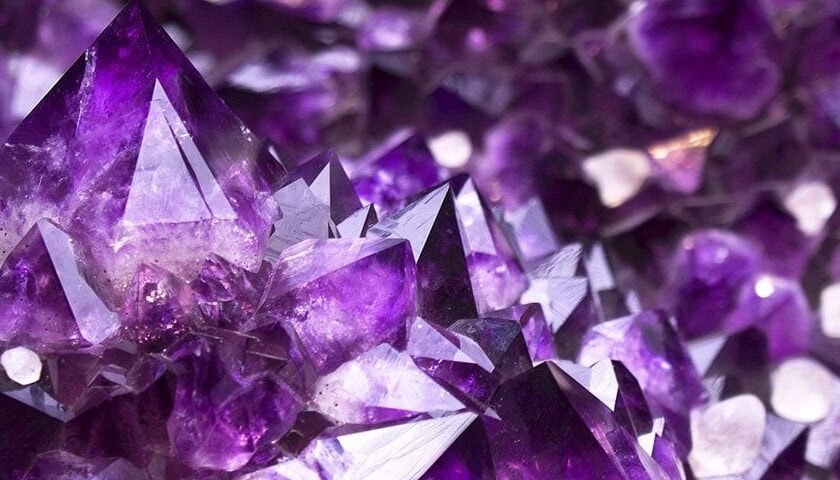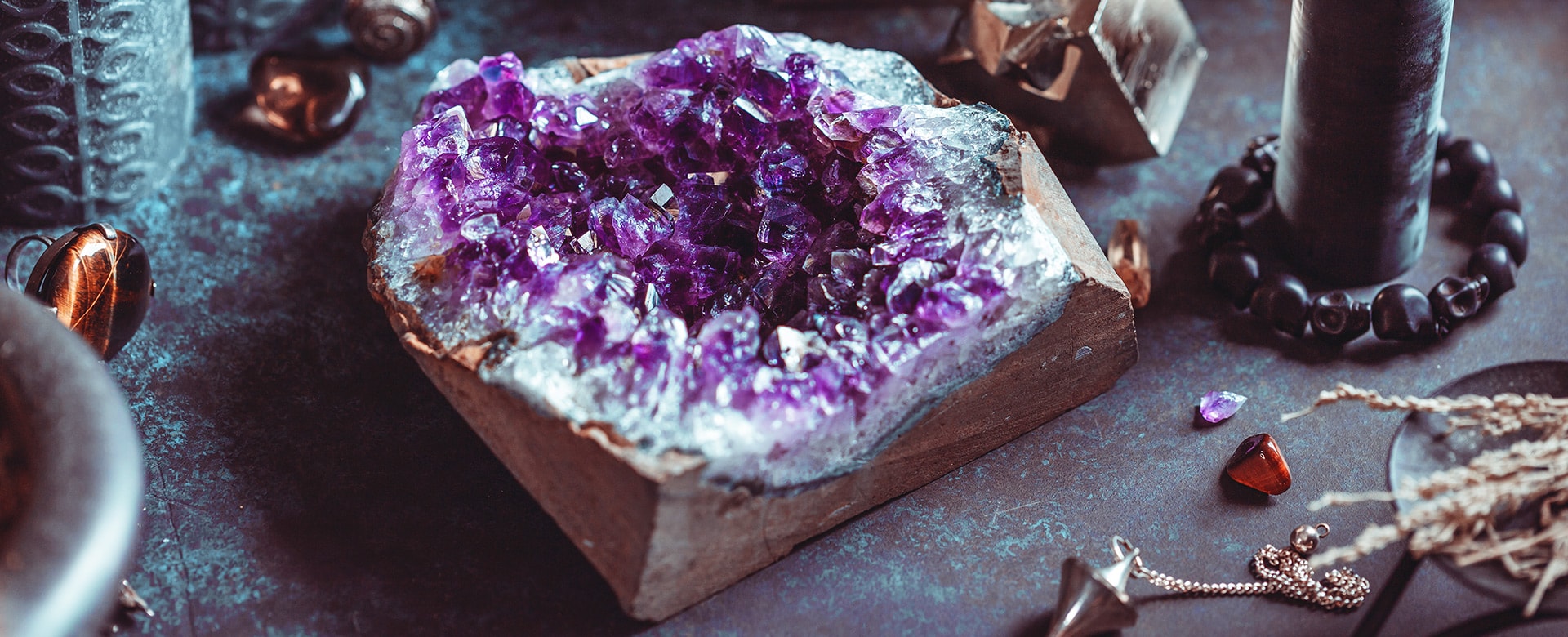Article Highlights
The Mystical Origins of Amethyst
Amethyst, a gemstone captivating hearts with its violet charm, has a name rooted in ancient Greek lore. The term ‘amethyst’ derives from the Greek words ‘a-‘ meaning ‘not’ and ‘methysko’ or ‘metho’, translating to ‘intoxicate’. This nomenclature ties back to a fascinating belief held by the Ancient Greeks. They thought that wearing amethyst or using it in their drinking vessels would shield them from the effects of alcohol, thus preventing drunkenness. This belief wasn’t just a mere superstition; it was a part of their lifestyle, as they often adorned themselves with amethyst jewelry and crafted drinking containers from this mesmerizing stone.
The Gemstone’s Composition and Structure
Peering into the depths of an amethyst reveals more than just a pretty face; it’s a complex dance of nature’s chemistry and physics. This purple quartz variety owes its stunning hue to a mix of factors: irradiation, iron impurities, and the presence of other trace elements. These factors lead to intricate crystal lattice substitutions, creating the gem’s signature color. Imagine a three-dimensional network of tetrahedra, with silicon atoms at the center, surrounded by oxygen atoms. This robust structure gives amethyst its renowned hardness and durability, making it an ideal candidate for jewelry that withstands the test of time and elements.

A Spectrum of Shades: The Color Palette of Amethyst
Amethyst isn’t just a one-note wonder; it sings in a range of purple tones. From light lavender whispers to deep purple declarations, the stone showcases an array of hues. It can even flirt with red and blue secondary tones, adding to its allure. Among its varieties, the ‘Deep Siberian’ grade stands out with a rich purple mixed with hints of blue and red, depending on the light. Conversely, ‘Rose de France’ amethyst boasts a lighter, more delicate shade, reminiscent of lavender and lilac. Once underrated, these pale hues have risen in popularity, thanks to effective marketing strategies.
The Enigma of Green Amethyst
Contrary to its name, green amethyst, scientifically known as prasiolite, is a variant of quartz with a verdant hue. It’s also known as vermarine or lime citrine, diversifying the amethyst family with its unique color.
The Challenge of Color Zoning in Amethyst
One intriguing aspect of amethyst is its color zoning. The intensity of color often peaks at the crystal’s terminations, presenting a challenge for gem cutters who strive to achieve a uniform color in the final product. Sometimes, only a thin layer of an uncut amethyst shows the desired violet color, or the distribution of color is uneven. This means that only a fraction of the natural gem is suitable for crafting into jewelry.
The Dynamic Nature of Amethyst’s Color
The amethyst’s color is a result of iron substitution by irradiation, influenced by trace elements. This stone is naturally dichroic, showing shades of reddish-violet and bluish-violet. However, when heat-treated, amethyst undergoes a dramatic transformation, taking on yellow-orange, yellow-brown, or dark brown hues, reminiscent of citrine but losing its dichroism. This process can also yield ametrine, a combination of amethyst and citrine colors in one stone. However, it’s important to note that amethyst can fade if overexposed to light and can be artificially darkened with irradiation. Unlike some gems, amethyst does not fluoresce under UV light.
Meanings, Healing, and Metaphysical Properties

Introduction to Amethyst: A Gem of Many Facets
Amethyst, a stone renowned for its stunning violet hue, has been cherished throughout history not only for its beauty but also for its purported metaphysical and healing properties. This gemstone, a variety of quartz, has captivated cultures worldwide with its deep purples and light lilac shades, embodying both elegance and mystical lore.
The Symbolic Meanings of Amethyst
A Stone of Sobriety and Clarity
Rooted in ancient Greek mythology, amethyst was believed to protect its bearer from drunkenness and overindulgence. This belief extends to a broader symbolic meaning where amethyst is seen as a stone of clarity, helping to clear the mind of negative thoughts and aiding in sobriety from various addictions.
Connection to the Divine
Amethyst is often associated with the divine and is believed to promote spiritual wisdom and enlightenment. It’s thought to enhance intuition and psychic abilities, making it a favored stone among spiritual practitioners and those seeking a deeper understanding of the universe.
The Stone of Tranquility and Peace
In the realm of emotional healing, amethyst is prized for its calming and soothing energies. It’s believed to bring peace and tranquility, alleviating stress and promoting a serene state of mind. This makes it an ideal stone for meditation and relaxation practices.
Healing Properties of Amethyst
Physical Healing Energies
While amethyst is primarily known for its spiritual and emotional healing properties, some practitioners attribute various physical healing abilities to this gemstone. It’s said to boost hormone production, improve the immune system, and aid in detoxification. Amethyst is also believed to help in treating headaches and reducing pain.
Emotional and Mental Healing
Amethyst’s calming energy is thought to be beneficial in treating mental disorders and aiding in emotional healing. It can help in alleviating sadness and grief and can provide support during times of loss. Its tranquil properties are also believed to help in treating insomnia and promoting restful sleep.
Spiritual Healing and Growth
Amethyst is considered a powerful tool for spiritual growth and healing. It’s thought to enhance spiritual awareness and open intuition, aiding in the development of psychic abilities. This stone is often used in meditation to deepen the experience and achieve a higher state of consciousness.
Metaphysical Properties of Amethyst
Chakra Alignment and Balancing
Amethyst is closely associated with the crown chakra, the energy center that governs our connection to the spiritual universe. It’s believed to help in opening and balancing this chakra, enhancing spiritual awareness and enlightenment. Some also associate amethyst with the third-eye chakra, promoting intuition and psychic abilities.
Enhancing Creativity and Passion
Apart from its spiritual benefits, amethyst is also thought to stimulate the mind and creativity. It’s believed to help in clearing mental fog, allowing for clearer thinking and decision making. This can lead to increased creativity and a renewed passion for life’s pursuits.
Protective Energies
Traditionally, amethyst has been used as a protective stone. It’s believed to create a shield of spiritual light around the body, protecting the wearer from negative energies and psychic attacks. This protective quality makes it a popular choice for those seeking a sense of safety and security.
Incorporating Amethyst into Daily Life
Jewelry and Personal Adornment
Wearing amethyst as jewelry is a popular way to benefit from its healing and metaphysical properties throughout the day. Whether as a necklace, bracelet, or ring, amethyst can serve as a constant source of its calming and protective energies.
Home and Workspace
Placing amethyst in living spaces or workplaces can help in creating a peaceful and harmonious environment. Its presence can aid in reducing stress and promoting a tranquil atmosphere, beneficial for both relaxation and productivity.
Meditation and Spiritual Practices
Amethyst is a powerful ally in meditation and other spiritual practices. Holding or placing amethyst nearby during meditation can enhance the experience, deepening relaxation and promoting spiritual insight.
The Global Footprint of Amethyst Mining
The Abundance of Amethyst in Brazil
Brazil stands as a titan in the world of amethyst, with the state of Rio Grande do Sul at the forefront. Here, amethyst is found in large geodes within volcanic rocks, often in the hollows of agates. Artigas, Uruguay, and the neighboring Brazilian state Rio Grande do Sul are known as major global producers, with other Brazilian states like Minas Gerais and Bahia contributing smaller quantities.
The Empress of Uruguay: A Monumental Discovery
In 2007, a remarkable discovery was made in Artigas, Uruguay. The largest amethyst geode ever found, dubbed the ‘Empress of Uruguay,’ stunned the world. Standing at over 3 meters tall and weighing a hefty 2.5 tons, this geode is a testament to the grandeur and mystery of nature’s underground treasures.
Amethyst Beyond South America
While South America reigns supreme in amethyst production, the gemstone’s reach is global. South Korea, Zambia, and even the United States boast significant deposits. The U.S. sees notable production in areas like Arizona and Georgia. Canada also plays a role, with Ontario and Nova Scotia housing ample deposits. Thunder Bay, Ontario, is home to the largest amethyst mine in North America.
Amethyst as a Cultural Icon
In South Carolina, amethyst’s significance is celebrated as the official state gemstone. The Smithsonian Museum of Natural History proudly displays several specimens, underscoring the gemstone’s cultural and geological importance.
The Intriguing Facets of Amethyst Varieties
Natural vs. Treated Amethyst
Amethyst’s natural beauty is undeniable, but it’s also a canvas for human creativity. The untreated stone displays its dichroic nature, flaunting shades of reddish and bluish violet. In contrast, heat treatment can transform amethyst into a range of colors from yellow-orange to dark brown, resembling citrine but losing its dichroic charm. This versatility is not just a testament to the stone’s beauty but also to its adaptability in the hands of skilled gem artisans.
The Rarity of Pink Amethyst
A lesser-known sibling in the amethyst family is the natural pink amethyst. This delicate variant, with its subtle, tender hues, adds a touch of uniqueness to the amethyst spectrum. The rarity of this coloration makes pink amethyst a coveted treasure for collectors and gem enthusiasts alike.
the Power of Amethyst: Uses and Applications
A Jewel in the Crown of Jewelry
Amethyst’s most celebrated use is in the realm of jewelry. Its durability, matched with its captivating hues, makes it a favorite for rings, necklaces, earrings, and bracelets. Whether set in gold, silver, or platinum, amethyst adds a touch of royal elegance to any piece of jewelry, making it a beloved choice for both everyday wear and special occasions.
Beyond Adornment: Amethyst in Other Domains
But the allure of amethyst extends beyond jewelry. Its rich color and unique properties have found applications in other domains as well. From ornamental carvings to decorative home accents, amethyst’s versatility shines through. Its presence in a room can add a touch of natural elegance and a splash of color that can transform a space.
The Future of Amethyst: Sustainability and Trends

Ensuring Sustainable Practices in Amethyst Mining
As the demand for amethyst remains high, the importance of sustainable mining practices comes to the forefront. Ensuring that amethyst is sourced responsibly and ethically is crucial for preserving the natural environments where it is found and supporting the communities involved in its extraction.
Emerging Trends and the Evolving Market
The market for amethyst is ever-evolving, with new trends emerging in jewelry design and consumer preferences. From innovative cuts and settings to the resurgence of previously less popular hues like the ‘Rose de France’, amethyst continues to adapt and thrive in the dynamic world of gemstones.



